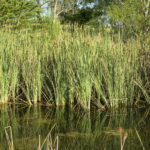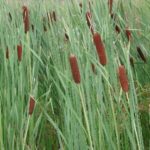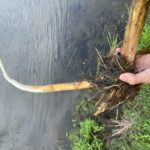Typha spp.
USDA, NRCS. 2018. The PLANTS Database (http://plants.usda.gov, 28 March 2018). National Plant Data Team, Greensboro, NC 27401-4901 USA.
Illustration courtesy of University of Florida/IFAS Center for Aquatic and Invasive Plants. Used with permission.
What is Cattail?
Physical Characteristics
Aquatic, perennial herb, 5 to 6 feet tall from large, creeping rhizomes.
Leaves:
- Arranged & straight
- Immobile
- Linear
- Fleshy
Flowers:
Fruit:
- Long-stalked small nut
Seeds:
- In the air
Stem:
- Simple
- Jointless
Where does Cattail grow?
EDDMapS. 2024. Early Detection & Distribution Mapping System. The University of Georgia – Center for Invasive Species and Ecosystem Health. Available online at http://www.eddmaps.org/; last accessed January 17, 2024.
Cattail normally grows in freshwater, forming dense colonies where salinities are very low, if any at all, but can be found in marshes where salinities reach 3.5 ppt.
Pros and Cons of Cattail
The rhizomes and lower leaf portions of cattails are consumed by nutria, muskrats, and geese. Submerged portions of all aquatic plants provide habitats for many micro and macro invertebrates. These invertebrates in turn are used as food by fish and other wildlife species (e.g. ducks). After aquatic plants die, their decomposition by bacteria and fungi provides food (called “detritus”) for many aquatic invertebrates.
What Type of Cattail Do I Have?
There are 3 species of Cattail in North America. Only 2 of theses species are common in Texas. Click on the buttons to learn more about each species.






